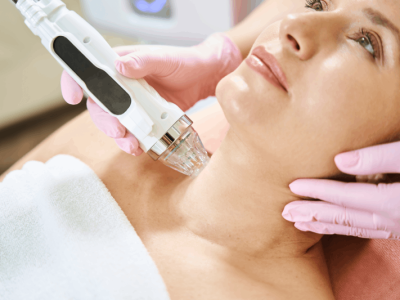Hyperpigmentation, marked by dark patches and uneven skin tone, is a common issue for many. Achieving a more even, radiant complexion requires careful treatment. This article outlines a detailed guide on the procedures for treating hyperpigmentation, emphasizing the various methods, preparation, and aftercare that lead to successful outcomes.
What Are the Step-by-Step Procedures Involved in Hyperpigmentation Treatment?
Treating hyperpigmentation involves clear steps to assess, prepare, and treat the skin for reducing dark spots and achieving an even tone. It starts with a consultation where a dermatologist evaluates the hyperpigmentation, identifies its causes, and considers the patient’s skin type. This assessment is essential for creating a personalized treatment plan.
Step 1: Initial Assessment and Skin Analysis
The first step is a detailed skin analysis. The dermatologist examines the skin to identify the type and depth of pigmentation, determining whether it is epidermal (surface level), dermal (deeper level), or mixed. Tools such as a Wood’s lamp may be utilized to assess the pigmentation and its response to light. Additionally, the dermatologist reviews the patient’s medical history, including prior treatments and skincare routines, to identify any factors that could influence the treatment’s effectiveness.
Step 2: Skin Preparation Before Treatment
Preparing the skin before treatment is crucial. This involves using mild cleansers to ensure the skin is free from impurities, oils, and makeup. Depending on the chosen treatment method, a topical anesthetic may be applied to minimize discomfort during the procedure. For treatments like chemical peels or laser therapy, a preparatory regimen may include the use of specific creams or serums designed to enhance the skin’s receptiveness to the treatment. This preparation phase is vital for maximizing the effectiveness of the procedure and minimizing potential side effects.
Step 3: Clinical Methods Used in the Treatment
The treatment of hyperpigmentation can involve several methods, each chosen based on the type of pigmentation and the patient’s skin type. Commonly used treatments include:
- Topical Treatments: Creams and serums containing active ingredients such as hydroquinone, retinoids, and vitamin C inhibit melanin production and promote cell turnover, gradually lightening dark spots.
- Chemical Peels: This method applies a chemical solution to exfoliate the skin’s top layers, reducing pigmentation over time. The depth of the peel—superficial, medium, or deep—is selected based on the severity of the hyperpigmentation.
- Laser Therapy: Laser treatments, such as Q-switched lasers, target melanin deposits in the skin. The laser energy breaks down these pigments into smaller particles, which are then absorbed and eliminated by the body.
- Microdermabrasion: A less invasive option, microdermabrasion exfoliates the skin with fine abrasive material, removing the outer layer to reduce pigmentation and improve texture.
Step 4: Variation Based on Skin Type
Skin type significantly influences the appropriate treatment for hyperpigmentation. Individuals with darker skin tones are more prone to post-inflammatory hyperpigmentation, requiring gentler treatments to avoid exacerbating the condition. In these cases, low-strength chemical peels or specific laser wavelengths that minimize skin damage are preferred. Conversely, lighter skin types may tolerate more aggressive treatments, such as higher-intensity laser therapy, with reduced risk of adverse effects.
How Do Laser Treatments for Hyperpigmentation Work?
Laser treatments are a cornerstone in managing hyperpigmentation due to their precision and effectiveness. During the procedure, a targeted laser beam is directed at the pigmented areas. The laser energy is absorbed by the melanin, causing it to fragment into smaller particles. The body’s natural healing processes then work to remove these fragmented pigments, resulting in a gradual lightening of the treated areas. Multiple sessions are often required to achieve optimal results, with the number depending on the depth and extent of the pigmentation.
What Aftercare Steps Are Crucial Following Treatment?
Aftercare is integral to the treatment process and significantly impacts the final outcome. Following treatment, the skin is often more sensitive and requires careful handling. Key aftercare steps include:
- Sun Protection: Patients should use a broad-spectrum sunscreen with an SPF of 30 or higher to protect treated areas from UV exposure, which can worsen pigmentation.
- Moisturization: Keeping the skin hydrated is essential, particularly after procedures like chemical peels or laser treatments that can cause dryness or peeling.
- Avoiding Irritants: It’s crucial to avoid harsh skincare products, such as exfoliants or retinoids, immediately after treatment to prevent irritation.
- Follow-Up Appointments: Regular follow-up visits with the dermatologist ensure the treatment is progressing as expected and allow for any necessary adjustments to the aftercare regimen.
The Role of Topical Treatments and Chemical Peels
Topical treatments are often used alongside other methods as part of the comprehensive approach to managing hyperpigmentation. These treatments help maintain results achieved by more intensive procedures and can be used for ongoing care. Ingredients like azelaic acid, kojic acid, and niacinamide are common in these formulations to inhibit melanin production and promote a more even skin tone.
Chemical peels provide controlled exfoliation of the skin’s upper layers, helping to lighten existing pigmentation while stimulating the production of new, healthy skin cells. The type and strength of the peel are selected based on the patient’s skin type and the severity of pigmentation, ensuring a tailored approach.
In summary, treating hyperpigmentation demands a personalized strategy. By grasping the procedures and the significance of customized treatment plans, individuals can attain a radiant and even complexion. With the right treatments and proper aftercare, achieving uniform skin becomes attainable and fulfilling.








Comments